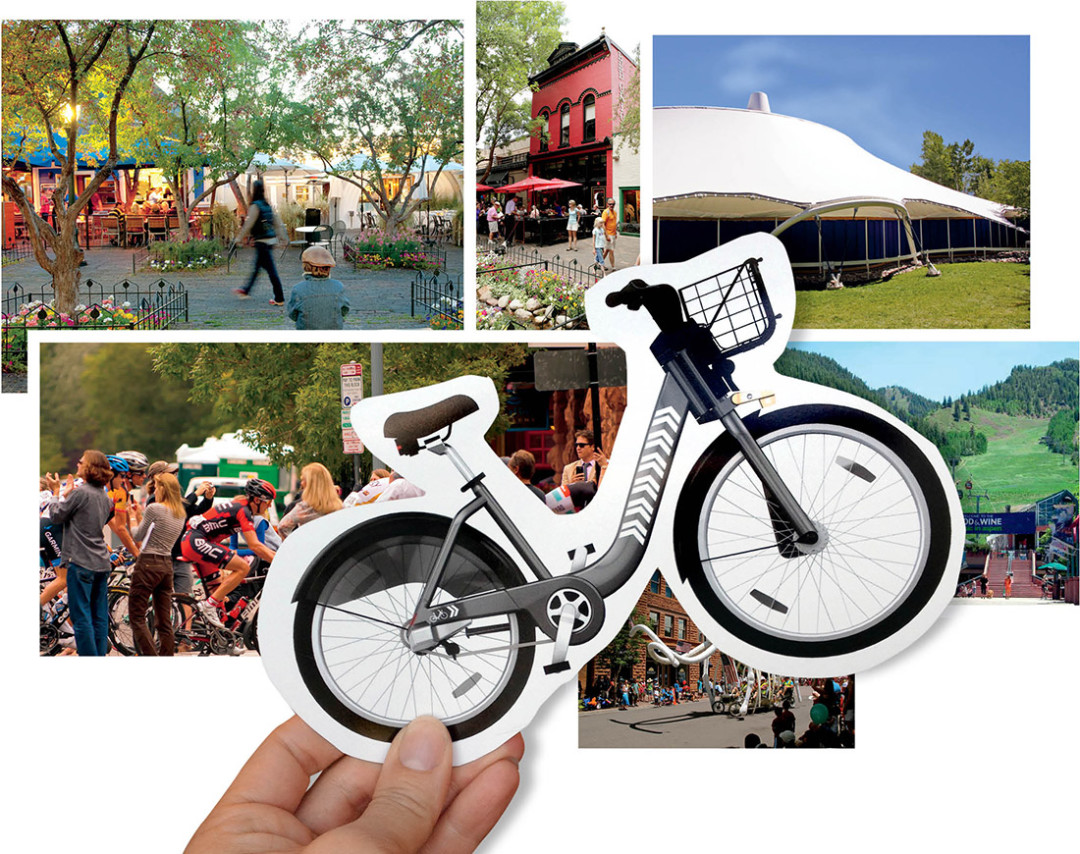Pedaling Progress

Photography: Clockwise From Top Left: Tim Kurnos; Brett Friel; Kim Klieger; Beelde Photography/Shutterstock.com; Tim Kurnos; Anne Reeser
Paris, Barcelona, Aspen. Any guess what connects them? No, Zara hasn’t set up shop on the Hyman Mall (though we would take that chic and cheap fast-fashion chain in a heartbeat). Here’s a hint: the answer goes by bicing in Barcelona and vélib’ (a portmanteau of vélo and liberté) in Paris.
Ding-ding! If you hear the ringing of a bicycle bell, you’ve guessed correctly. In early June, Aspen debuts WE-cycle, the first bike-sharing program outside of a major metro area in the US. It’ll be hard to miss: WE-cycle places 100 bicycles at twelve solar-powered docking stations around town. Swipe a credit card at one of them—say, the Aspen Institute’s—and you’re on the hook for $7 for the day and entitled to as many thirty-minute, station-to-station intervals as your legs can pedal. Other permanent station locations include the gondola plaza, Ruby Park, the Aspen Valley Hospital, and the Aspen Club & Spa. The docks can even be relocated for special events (Food & Wine Classic, Ideas Fest) that increase demand at certain spots in town.
Why does a town whose citizens are more likely to own a bike than a car need a bike-sharing program? “Because it’s not for Aspen’s 6,000 full-time residents,” says Mirte Mallory, WE-cycle’s cofounder. “It’s for visitors and commuters. The bikes are the perfect complement to RFTA [the valley’s bus system]—we say for that last mile after people get off the bus. They’re for short trips.”
WE-cycle is not short on technology. There’s an app (Cycle Finder, for both WE-cycle and other similar programs around the country) that tracks real-time bike availability, dock availability, and station locations, as well as how long you’ve been out. The bikes’ built-in GPS units allow a “bike balancer” to ensure that there are enough bikes at every station (or, if a station is full, to remove bikes and free up docking space). Broken bikes can be locked down.
Should we pity the poor bike shop, where rental business could suffer for all the tourists opting for $7 rides? Not at all. In advance of its launch, WE-cycle connected with local bike shops. Their names and locations appear on docking station maps, and, more critical for bike shops’ day-rental business, the network’s user fees become prohibitively expensive after two hours. WE-cyclers who haven’t redocked their bike after the free thirty minutes pay $2 for the first fifteen minutes thereafter and $5 for each fifteen after that. Assuming the $7 day rate (there are also three-day, seven-day, and season passes), taking a WE-cycle bike on a three-hour cruise would cost $54—more than renting something basic from a local shop.
Besides which, “bike-sharing increases bike usage, helmet sales, and gear sales,” says Mallory. “And it encourages street-side interaction among strangers. There’s a shared, collective feel. We can pedal ourselves to a happier, cleaner community.”
That’s a ride we’re willing to try.













































